

The $270 million battle to save an iconic London bridge from falling into the River Thames. Is it any wonder that London bridges are falling down?
For hundreds of years, they have worked tirelessly to carry the load of one of the world's busiest cities. Key points: Hammersmith Bridge has been shut to cars since April 2019 and to pedestrians and cyclists since August 2020The bridge was shut due to the danger of it collapsing, and will require a $270 million renovation to reopenAn increase in traffic and the effects of climate change are putting added pressure on all of London's bridges But many of the 35 bridges that span the Thames were originally built to carry horse and cart, and the strain of modern-day traffic is taking its toll. The magnificent Hammersmith Bridge is a case in point. Green Valley's social housing experiment still being fixed 60 years later. Green Valley was built under unusual circumstances 60 years ago.

Walk through some parts of it today and you'll be able to spot remnants of that bygone era. The south-west suburb was developed by the NSW Housing Commission during the affordable housing crisis in the 1960, on farming land at the fringes of Sydney's suburban sprawl. People — especially large families living in cramped houses in the inner city — were moved there. Some were given houses and others were placed in large, brick complexes. While the urban development boom has since swallowed the valley, parts of it, especially its social housing, still look the same. "I feel it was an experiment that caused a lot of angst for a lot of people," Liverpool Mayor and life-long resident, Wendy Waller, said.
Apartment design and property development skewered by architects in NGV Triennial artwork. After a year spent mostly in our homes, a visit to a gallery is meant to feel like an escape.

But a new work at the National Gallery of Victoria will make many apartment dwellers feel like they've taken a wrong turn and are somehow home again. Designed to look like a display suite, the artwork consists of two connected rooms with grey carpet, white walls, thick black window frames, square basins, glass box showers and chrome fittings — familiar elements to anyone who has gone apartment-hunting in recent years, let alone lived in a new apartment. But look again and you'll notice that there's something not quite right: the toilet is gargantuan, there's a bedroom hidden under the kitchen island, and the open-plan living area narrows to a vanishing point. Elderly NSW flood veterans can help predict weather cycles, expert says.
Ted Books admits his memory isn't what it used to be, after all, he's 86.
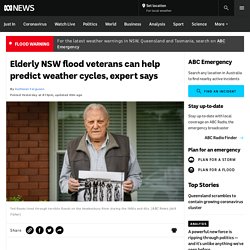
But there's one thing the Sydney man can recount without skipping a beat — floods. He remembers hauling people into rescue boats on the Hawkesbury River in the 1950s and 60s, when things got really bad. This week, several areas along the Hawkesbury were ordered to evacuate, with water levels reaching more than 12 metres at Windsor, flooding homes and cutting off roads and bridges. Mr Books knew it was history repeating itself — problem is, no one listens to him. Australia is likely about to enter a wetter climate cycle, and that's a problem for the Hawkesbury-Nepean Valley. The region was the epicentre of Sydney's floods that sparked widespread evacuations and left one man dead last week. The engineering and environmental geologist said people in the area with a lived-knowledge of the last wet cycle — which saw regular floods in the 1950s and 60s — were elderly, and often ignored.
'One-in-100-years' flood talk disastrously misleading and should change, risk experts say. What does it mean when a natural disaster is described as a "one-in-50-years" or "one-in-100-years" event?
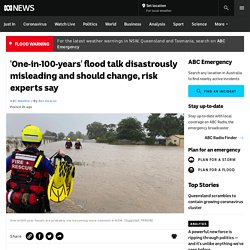
Well, not what most people think and that has to change, according to a leading risk assessment expert. Key points: A one-in-100-year flood has a 1 per cent chance of occurring any yearTown planners use one-in-100-year floods to decide where housing can be builtOne-in-100-year floods are probably not becoming more common in NSW Thomas Mortlock, from consultancy Risk Frontiers, said "100-year floods" don't just happen once every 100 years.
Satellite images of Hawkesbury River flooding show true extent of NSW devastation. Satellites orbiting the earth's exosphere have been able to capture the true extent of the past week's flood devastation in NSW.

The imagery shows fields and properties along the Hawkesbury River completely underwater. The entire NSW coast has been drowned by at least 200 millimetres, and in some places, more than 400mm of rain. To put that in context, Sydney averages 132mm of rain for the whole month of March. As the pictures show, much of Windsor and its surrounding areas have been swallowed by the swollen river and houses are now islands in an ocean of flood water. Unexpected wildlife encounters part of communing with nature for people living in the bush. As people leave the big smoke during the COVID-19 pandemic, what awaits them as they move to the bush and closer to nature?
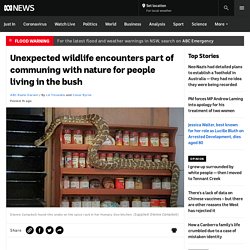
Key points: Moving to the bush opens up a new world of communing with natureMany Northern Territorians have stories of finding wildlife where it shouldn't beThe expert advice is to appreciate that humans are living in animal habitats Australian Bureau of Statistics data has confirmed the nation's big cities have been losing people in record numbers during COVID-19. Among the coronavirus refugees are those moving their lives to the Northern Territory.
But are they prepared for life in un-civilisation — and the unusual wildlife encounters that can happen? Imagine arriving at your new Territory home and there's a water monitor basking on your verandah, a snake on your spice rack, frogs in your toilet bowl, buffalo at the back door, peacocks committing murder in the chicken pen, and a crocodile in your yard. They called her buff. Housing pressure escalates in south-east Queensland as Moreton Bay region to exceed Tasmanian population by 2032. South-east Queensland's population is predicted to surge by more than 2 million people within the next two decades and residents living between Brisbane and the Sunshine Coast are already feeling the escalating housing pressures.

Key points: Research finds Moreton Bay would need to build another 88,000 homes to accommodate a population surgeThe growth is sparking concerns about a lack of infrastructure and damage to the natural environmentExperts say there needs to be a greater focus on community involvement in the planning stages The Moreton Bay region is one of the fastest growing in south-east Queensland, according to a Queensland government research paper. It is home to 470,000 residents, making it the third largest council in Australia.
The trend has no sign of slowing with the ShapingSEQ report forecasting an additional 240,000 residents will call the Moreton Bay region home by 2036. NT men still outnumber women as COVID hits multi-million-dollar population strategy. Darwin is Australia's only capital city with more men than women and it may stay that way after the COVID-19 pandemic and closure of state borders forced the Northern Territory government to put its multi-million-dollar population strategy on hold.
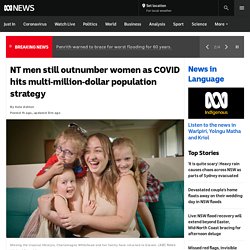
Key points: Darwin is Australia's only capital city where men outnumber womenThe NT government has halted a $50 million strategy to grow the populationIsolation from family is one of the main reasons women leave the Territory In 2018, amid a national publicity blitz linked to its Boundless Possible campaign, the government launched a $50 million two-year strategy across multiple agencies to help boost the Territory's population, drive economic growth and create jobs, especially for women. The strategy included a range of incentives targeting women aged 20 to 39 years to move to the Territory, including cash incentives if they applied for stipulated "high priority" jobs.
Pungent odor from Western Sydney 'unauthorised' pet food factory forces family indoors. Residents in the Western Sydney suburb of Toongabbie say their lives are being ruined by the smell coming from an "unauthorised" suburban pet food factory.
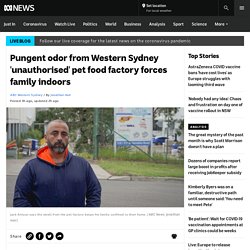
Parramatta City Council fined the owners of the Yummi Pet Food Products warehouseThe company ignored a stop work order and the council intends to send anotherResidents fear the company will make a development application to continue to operate "It just smells like raw, rotten meat … a garbage tip is a good way to describe it," neighbour Matt Chalmers said. The Yummi Pet Food Products warehouse is meant to only be used for storing goods. But instead, it is being used to produce pet treats and food. Australians face a hotter future if our cities don't do more to cool 'heat islands', report finds. Most major Australian cities will be far hotter than forecast in coming years, as a lack of vegetation creates "heat islands," especially in poorer areas, a new report warns. Key points: Most major cities lost green cover between 2013 and 2020"Heat islands" can form in built-up cities that trap warm airTemperatures are already set to rise because of climate change The report, Temperature Check: Greening Australia's Warming Cities, commissioned by the Australian Conservation Foundation, found green spaces in almost all major cities had declined in the last decade.
The country's greenest capital, Hobart, was the only city to increase its green cover between 2013 and 2020 — but even then, it was only by 1 per cent. The report said other capital cities had major work to do to increase vegetation, or avoid becoming almost unbearable in coming decades as climate change raises temperatures worldwide. Dr Richardson highlighted Western Sydney as one urban region at risk of becoming "unliveable".
Rental prices rise, vacancies disappear as Snowy Monaro town struggles to balance new arrivals and workers. After raising five children, fostering more than 100, and having a successful career in the Australian Defence Force, Karen Morris never expected to be sleeping on the floor in her granddaughter's bedroom. Key points: Australian housing needs mandatory accessibility standards to create 'homes, not just accommodation', advocates say. More than 30 organisations have written an open letter to the Prime Minister and state and territory leaders urging them to "futureproof Australian housing" through mandatory accessibility standards as part of the national construction code. Key points: Many people who live with disability are forced to fund expensive new modifications just to get out of nursing homesThe most common areas needing accessibility changes are entrances to kitchens, bathrooms and bedroomsExperts say it is 22 times more expensive to renovate a house than to build it with accessibility features upfront Signed by groups representing people with disability, older Australians, health professionals and parts of the housing sector, the letter comes ahead of a meeting of building ministers next month where accessibility is set to be one of the issues.
If adopted, the proposal would impact every newly built home in Australia. Australian-first CDU study finds COVID-19 could help grow the NT's stagnant population. Lea Riley faced being stranded and homeless in Sri Lanka when COVID-19 began to spread around the world last March. Key points: Australia's first population-oriented COVID-19 research has found people are more likely to remain in the NT long-termThose surveyed said the pandemic had made the NT a more attractive place to liveNet interstate migration in Darwin has also risen for the first time in several years The Melbourne nurse was living and working in Saudi Arabia, but had been holidaying in Sri Lanka when she heard Prime Minister Scott Morrison's warning that Australian borders could close. "We got locked out of Saudi Arabia and I had to fly to the UK with my British friends, and I found out I had to head home," she said.
Ecologists buy 1,000-acre blue gum plantation and transform it into wetland it once was. It was 2016, Mark Bachmann was stumped. He and his team of scientists were three years into transforming a huge tract of agricultural land into the wetland it once was, but had no idea how their small, regional, not-for-profit could negotiate the final step: to buy 1,000 acres of commercial blue gum plantation.
That was when he spotted the platypus. "I drove out after a big flood to see how our two trial swamps were looking, I'd just taken a few steps off the road and saw a black thing moving up along the bank of a deep drain," Mr Bachmann said. "I thought it might be a water rat, but then I got a look at the bill and I thought, 'Oh my goodness, it's a platypus! '" he said. Flying foxes are crucial to the ecosystem, but should they stay in suburbia?
Part of Tasmania's historic Waddamana hydro-electric village up for sale. FOI documents show Darwin's $2.7m shade structure reduces heat by less than 1C. Coal-rich Hunter Valley ponders jobs future as Asian giants commit to net-zero carbon emissions. At the Lochinvar pub in the NSW Hunter Valley, a couple of power industry workers meet for a drink and ponder the future.
How to make your home more resilient to heatwaves and severe storms in summer - Science. Some parts of Australia are sweltering as a heatwave moves from Adelaide across to the east coast. The City of Churches is no stranger to heatwaves. In February 2017, the city experienced temperatures above 40 degrees Celsius for three consecutive days. At night, temperatures didn't drop below 30 degrees. Heatwaves may mean Sydney is too hot for people to live in 'within decades'